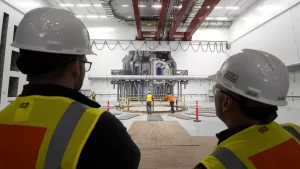‘World’s first’ grid-scale nuclear fusion power plant to be in VA
If all goes to plan, Virginia will be the site of the world’s first grid-scale nuclear fusion power plant, able to harness this futuristic clean power and generate electricity from it by the early 2030s, according to an announcement Tuesday by the startup Commonwealth Fusion Systems.
CFS, one of the largest and most-hyped nuclear fusion companies, will make a multibillion-dollar investment into building the facility near Richmond. When operational, the plant will be able to plug into the grid and produce 400 megawatts, enough to power around 150,000 homes, said its CEO Bob Mumgaard.












